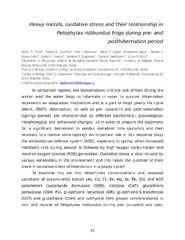Приказ основних података о документу
Heavy metals, oxidative stress and their relationship in Pelophylax ridibundus frogs during pre- and posthibernation period
| dc.creator | Prokić, Marko | |
| dc.creator | Gavrilović, Branka | |
| dc.creator | Krizmanić, Imre | |
| dc.creator | Gavrić, Jelena | |
| dc.creator | Nasia, Mohammed | |
| dc.creator | Borković Mitić, Slavica | |
| dc.creator | Pavlović, Slađan | |
| dc.creator | Despotović, Svetlana | |
| dc.creator | Radovanović, Tijana | |
| dc.creator | Saičić, Zorica | |
| dc.date.accessioned | 2019-07-12T08:08:48Z | |
| dc.date.available | 2019-07-12T08:08:48Z | |
| dc.date.issued | 2017 | |
| dc.identifier.uri | https://radar.ibiss.bg.ac.rs/handle/123456789/3420 | |
| dc.description.abstract | In temperate regions, low temperatures and the lack of food during the winter lead the water frogs to hibernate in order to survive. Hibernation represents an adaptation mechanism and is a part of frogs yearly life cycle (Wells, 2007). Hibernation, as well as pre- (autumn) and post-hibernation (spring) periods are characterized by different biochemical, physiological, morphological and behavioral changes, all in order to prepare the organisms for a significant depression in aerobic metabolic rate (autumn) and then recovery to a normal state (spring). An important role in this response plays the antioxidative defense system (AOS), especially in spring, when increased metabolic rate during arousal is followed by high oxygen consumption and reactive oxygen species (ROS) generation. Oxidative stress is also induced by various xenobiotics in the environment and this raises the question of their share in oxidative stress of hibernators in a yearly cycle? To examine this we first determined concentrations and seasonal variations of accumulated metals (As, Cd, Cr, Fe, Hg, Ni, Pb, Zn) and AOS parameters (superoxide dismutase (SOD), catalase (CAT), glutathione peroxidase (GSH- Px), glutathione reductase (GR), glutathione-S-transferase (GST) and glutathione (GSH) and sulfhydryl (SH) groups concentrations) in skin and muscle of Pelophylax ridibundus during pre- (autumn) and post- hibernation (spring) periods, and second we evaluated the possible relationship between accumulated metals and AOS parameters. The results showed seasonal variation of accumulated concentrations: autumn frogs were characterized by higher concentrations of Ni, Cr and Hg, while frogs sampled in spring had higher As and Cd. On the other hand almost all AOS parameters were higher during the spring in comparison to individuals from autumn (in skin SOD, CAT, GR, GST, GSH and SH groups, while in muscle SOD, CAT, GSH-Px, GR and SH groups). The number of significant correlations between accumulated metals and AOS parameters were very similar in frogs from both seasons. All results showed that oxidative stress in the post-hibernating season was mainly caused by the organism’s recovery from hibernation, and that the metals did not contribute significantly to this response, indicating that natural selection affected AOS of the frogs in that way that during arousal they were able to produce higher levels of antioxidant defenses. | en |
| dc.language.iso | en | sr |
| dc.publisher | Association of Naturalists Students of the Jagiellonian University | sr |
| dc.rights | openAccess | sr |
| dc.source | Abstract Book: Conference of young evolutionary biologist; 2017 Jun 2-4; Krakow, Poland | sr |
| dc.title | Heavy metals, oxidative stress and their relationship in Pelophylax ridibundus frogs during pre- and posthibernation period | en |
| dc.type | conferenceObject | sr |
| dc.rights.license | ARR | sr |
| dcterms.abstract | Борковић-Митић, Славица; Павловић, Слађан; Деспотовић, Светлана; Радовановић, Тијана; Прокић, Марко; Гавриловић, Бранка; Гаврић, Јелена; Насиа, Мохаммед; Саичић, Зорица; | |
| dc.rights.holder | Association of Naturalists Students of the Jagiellonian University | sr |
| dc.citation.spage | 45 | |
| dc.citation.epage | 46 | |
| dc.type.version | publishedVersion | sr |
| dc.identifier.fulltext | https://radar.ibiss.bg.ac.rs//bitstream/id/5245/Conference-of-young-evolutionary-biologists-2017-45-46.pdf | |
| dc.identifier.rcub | https://hdl.handle.net/21.15107/rcub_ibiss_3420 |

